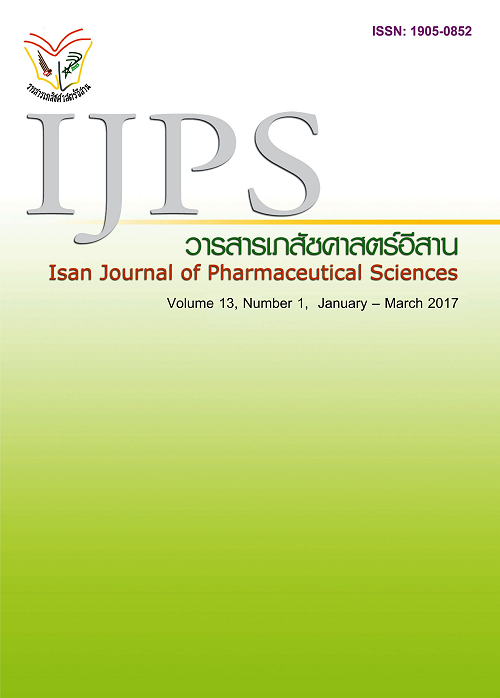Appropriate Dose of Standard Anti-Tuberculosis Regimen to Induce Hepatotoxicity in Mice
Main Article Content
Abstract
Introduction: The current regimen of anti-tuberculosis drugs has to combine several drugs for long period for the efficacy to eliminate infection and prevention of drugs resistance. But the most important of anti-tuberculosis drugs is hepatotoxicity. This study aimed to investigate the appropriate dose of anti-tuberculosis drug regimen in animal model for further study to develop the new compound against anti-tuberculosis toxicity. Methods: The 7-week-old male ICR mice were given standard regimen of anti-tuberculosis (Isoniazid (H), Rifampicin (R), Pyrazinamide (Z), and Ethambutol (E) at the dose of normal human 5-times (HRZE-5) and 10-times (HRZE-10) for 7 and 14 days. After that, mouse livers were collected for histopathological examination using hematoxyline and eosin staining with analyzing the activities of superoxide dismutase (SOD) and catalase (CAT). Results: The damage of hepatic tissue and the abnormality was observed after receiving anti-tuberculosis drug both of 5-times (HRZE-5) and 10-times (HRZE-10) for 7 and 14 days. Hydropic degeneration, Karyolysis and the trend to become Piecemeal necrosis of hepatic cells were observed. The hepatic SOD and CAT enzyme activities were significantly decreased in HRZE-5 and HRZE-10 groups in mice which were treated for 7 and 14 days. Conclusion: Anti-tuberculosis regimens of HRZE-5 and HRZE-10 induced the hepatotoxicity by tissue damage and reduction of activity SOD and CAT enzymes. Hence, the model in this study at 7 and 14 days is appropriate for further study about new compounds to protect hepatoxicity by anti-tuberculosis drugs. However, the investigation only SOD enzyme and CAT enzyme activity may not enough to reflect the total result of hepatic cells damage. Therefore, the hepatic histopathology is necessary to be the supported information for more accurately in showing the damage that occur in the hepatic cells.
Article Details
In the case that some parts are used by others The author must Confirm that obtaining permission to use some of the original authors. And must attach evidence That the permission has been included
References
Attri S, Rana SV, Vaiphei K, et al. Isoniazid- and rifampicin-induced oxidative hepatic injury -protection by N-acetylcysteine. HET 2000; 19: 517-522.
Castro AT, Mendesb M, Freitasa S, Roxoc PC. Incidence and risk factors of major toxicity associated to first-line antituberculosis drugs for latent and active tuberculosis during a period of 10 years. Rev Port Pneumol 2015; 21(3): 144-150.
Chang KC, Leung CC, Yew WW, Lau TY, Tam CM. Hepatotoxicity of pyrazinamide cohort and case-control analyses. Am J Respir Crit Care Med 2008; 177: 1391-1396.
Chatuphonpraserta W, Udomsuk L, Monthakantirat O, Churikhit Y, Putalun W, Jarukamjorn K. Effects of Pueraria mirifica and miroestrol on the antioxidation-related enzymes in ovariectomized mice. J Pharm Pharmacol 2012; 65: 447-456.
Demetrius L. Of mice and men. EMBO Rep 2005; 6: S39-S44.
Eamsumang N, Khumsaeng P, Panko S. Nature of died of tuberculosis patients in Rayong year 2009-2011. Chonburi: Office of Disease Prevention and Control 3 Chonburi; 2013. Sponsored by Office of Disease Prevention and Control 3 Chonburi.
Eminzade S, Uras F, Izzettin FV. Silymarin protects liver against toxic effects of anti-tuberculosis drugs in experimental animals. Nutr Metab 2008; 5(18): 1-8.
Fukai T, Fukai MU. Superoxide Dismutases: role in redox signaling, vascular function, and diseases. Antioxid Redox Signal 2011; 15(6): 1583-1606.
Jearapong N, Chatuphonprasert W, Jarukamjorn K. Effect of tetrahydrocurcumin on the profiles of drug-metabolizing enzymes induced by a high fat and high fructose diet inmice. Chem Biol Interact 2015; 239: 67-75.
Jittimanee S, Vorasingha J, Mad-asin W, Nateniyom S, Rienthong S, Varma JK. Tuberculosis in Thailand: epidemiology and program performance, 2001-2005. Int J Infect Dis 2009; 13:436-442.
Kheyabany SSK, Nabavizadeh F, Vaezi GH, et al. Protective effect of Ghrelin on isoniazid-induced liver injury in rat. J Stress Physiol Biochem 2013; 9(1): 273-282.
Mak IWY, Evaniew N, Ghert M. Lost in translation: animal models and clinical trials in cancer treatment. Am J Transl Res 2014; 6(2): 114-118.
Maryam S, Bhatti ASA, Shahzad AW. Protective effects of Silymarin in isoniazid induced hepatotoxicity in rabbits. ANNALS 2010; 16(1): 43-47.
Matés JM. Effects of antioxidant enzymes in the molecular control of reactive oxygen species toxicology. Toxicology 2000; 153(1-3): 83-104.
Matsumoto AO, Fridovich I. Subcellular distribution of superoxide dismutases (SOD) in rat liver. J Biol Chem 2001; 276(42): 38388-38393.
Nair N, Wares F, Sahu S. Tuberculosis in the WHO South-East Asia Region. Bull World Health Organ 2010; 88(3): 161-240.
Ramappa V, Aithal GP. Hepatotoxicity related to anti-tuberculosis drugs: mechanisms and management. J Clin Exp Hepatol 2013; 3(1): 37-49.
Ścibior D, Czeczot H. Catalase: structure, properties, functions. Postepy Hig Med Dosw 2006; 60: 170-180.
Speakman JR. Measuring energy metabolism in the mouse –Theoretical, Practical, and Analytical Considerations. Front Physiol 2013; 4(34): 1-23.
Szymonik-Lesiuk S, Czechowska G, Stryjecka-Zimmer M, et al. Catalase, superoxide dismutase, and glutathione peroxidase activities in various rat tissues after carbon tetrachloride intoxication. J Hepatobiliary Pancreat Surg 2003; 10: 309-315.
Tostmann A, Boereeb MJ, Petersc WH, et al. Isoniazid and its toxic metabolite hydrazine induce in vitro pyrazinamide toxicity. Int J Antimicrob Agents 2008; 31(6): 577-580.
Weydert CJ, Cullen JJ. Measurement of supperoxide dismutase, catalase, and glutathione peroxidase in cultured cells and tissue. Nat Protoc 2010; 5(1): 51-66.
World Health Organization Country Office for Thailand. Tuberculosis [online]. [cited 14 Jun 2016]. Available from: https://www.searo.who.int/thailand/areas/tuberculosis/en/
World Health Organization. Global tuberculosis report 2014. France: World Health Organization; 2014.
World Health Organization. Treatment of tuberculosis guidelines .Geneva: World Health Organization; 2010.
Zelko IN, Mariani TJ, Folz RJ. Superoxide dismutase multigene family: a comparison of the CuZn-SOD (SOD1), Mn-SOD (SOD2) and EC-SOD (SOD3) gene structure, evolution and expression. Free Rad Biol Med 2002; 33(3): 337-349.
Zotova EV, Savostianov KV, Chistiakov DA, et al. Association of polymorphic markers for genes coding for antioxidant defense enzymes, with development of diabeticpolyneuropathies in patients with type 1 diabetes mellitus. Mol Biol 2004; 38(2): 244-249.
Zou Y, Zhang Y, Han L, et al. Oxidative stress-mediated developmental toxicity induced by isoniazide in zebrafish embryos and larvae. J Appl Toxicol 2017; doi: 10.1002/jat.3432.

